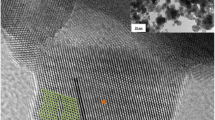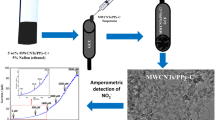Abstract
In this study, we investigate the electrochemical behavior of palladium nanoparticles (PdNP) deposition on glassy carbon electrode (GCE) in two deep eutectic solvents, namely, reline and ethaline, and its application in DNA sensors. The electrochemical behaviors of PdNP deposition are investigated by cyclic voltammetry and chronoamperometry. The obtained results indicate that the PdNP deposition on GCE in reline was dominated by the progressive 3D nucleation mechanism, while that in ethaline was dominated by the instantaneous nucleation mechanism. The structural, morphological, and compositional characteristics are also investigated through X-ray diffraction, field emission scanning electron microscopy, and energy-dispersive X-ray spectroscopy. A PdNP-based DNA sensor is constructed for Mycobacterium tuberculosis detection. Results indicate a significant difference between the DNA sensing responses based on the PdNPs synthesized in reline (PdNP-RE) and ethaline (PdNP-ET). The PdNP-ET–based DNA sensor has higher sensitivity than the PdNP-RE–based DNA sensor. This study serves as a reference for the development of improved nanomaterials for bioanalysis and the elaborate design of biosensors for practical applications.











Similar content being viewed by others
References
Abbott AP et al (2003) Novel solvent properties of choline chloride/urea mixtures Electronic supplementary information (ESI) available: spectroscopic data. Chem Commun 1:70–71
Abbott AP et al (2001) Preparation of novel, moisture-stable, Lewis-acidic ionic liquids containing quaternary ammonium salts with functional side chains. Chem Commun 19:2010–2011
Hammons JA et al (2016) Supported silver nanoparticle and near-interface solution dynamics in a deep eutectic solvent. J Phys Chem C 120(3):1534–1545
Rayée Q et al (2017) Underpotential deposition of silver on gold from deep eutectic electrolytes. Electrochim Acta 237:127–132
Li A et al (2017) Shape-controlled electrochemical synthesis of Au nanocrystals in reline: control conditions and electrocatalytic oxidation of ethylene glycol. RSC Adv 7(32):19694–19700
Xie X et al (2016) Voltammetric study and electrodeposition of Cu from CuO in deep eutectic solvents. J Electrochem Soc 163(9):D537–D543
Sebastián P et al (2017) Copper underpotential deposition at gold surfaces in contact with a deep eutectic solvent: new insights. Electrochem Commun 78:51–55
Vieira L et al (2017) Tin, bismuth, and tin–bismuth alloy electrodeposition from chlorometalate salts in deep eutectic solvents. ChemistryOpen 6(3):393–401
Salomé S et al (2013) Tin electrodeposition from choline chloride based solvent: influence of the hydrogen bond donors. J Electroanal Chem 703:80–87
Song Y et al (2017) Interfacial assistant role of amine additives on zinc electrodeposition from deep eutectic solvents: an in situ X-ray imaging investigation. Electrochim Acta 240:90–97
Li R et al (2015) Enhanced corrosion performance of Zn coating by incorporating graphene oxide electrodeposited from deep eutectic solvent. RSC Adv 5(75):60698–60707
Lanzinger G et al (2013) Electrodeposition of palladium films from ionic liquid (IL) and deep eutectic solutions (DES): physical–chemical characterisation of non-aqueous electrolytes and surface morphology of palladium deposits. Trans IMF 91(3):133–140
Renjith A et al (2014) In situ fabrication of electrochemically grown mesoporous metallic thin films by anodic dissolution in deep eutectic solvents. J Colloid Interface Sci 426:270–279
Hammons JA et al (2013) Stability, assembly, and particle/solvent interactions of Pd nanoparticles electrodeposited from a deep eutectic solvent. J Phys Chem C 117(27):14381–14389
Landa-Castro M et al (2022) Electrochemical nucleation and growth of Pd-Co alloy nanoparticles from the reline deep eutectic solvent. J Electrochem Soc 169:092521
Espino-López IE et al (2019) Palladium nanoparticles electrodeposition onto glassy carbon from a deep eutectic solvent at 298 K and their catalytic performance toward formic acid oxidation. J Electrochem Soc 166(1):D3205–D3211
Lu L-M et al (2011) In situ synthesis of palladium nanoparticle–graphene nanohybrids and their application in nonenzymatic glucose biosensors. Biosens Bioelectron 26(8):3500–3504
Wang H et al (2013) A silver–palladium alloy nanoparticle-based electrochemical biosensor for simultaneous detection of ractopamine, clenbuterol and salbutamol. Biosens Bioelectron 49:14–19
Zhang C et al (2019) Rolling circle amplification-mediated in situ synthesis of palladium nanoparticles for the ultrasensitive electrochemical detection of microRNA. Analyst 144(12):3817–3825
Baccar H et al (2011) Functionalized palladium nanoparticles for hydrogen peroxide biosensor. Int J Electrochem 2011:1–4
Meng T et al (2020) Pd nanoparticles-DNA layered nanoreticulation biosensor based on targetcatalytic hairpin assembly for ultrasensitive and selective biosensing of microRNA-21. Sens Actuators B Chem 323:128621
Savéant J-M, Costentin C (2019) Elements of Molecular and Biomolecular Electrochemistry: An Electrochemical Approach to Electron Transfer Chemistry, 2nd Edition. JohnWiley & sons Inc. ISBN: 978-1-119-29235-7. https://doi.org/10.1002/9781119292364
Elgrishi N et al (2018) A practical beginner’s guide to cyclic voltammetry. J Chem Educ 95(2):197–206
Berzins T et al (1953) Oscillographic polarographic waves for the reversible deposition of metals on solid electrodes. J Am Chem Soc 75(3):555–559
Mejía-Caballero I et al (2018) Mechanism and kinetics of chromium electrochemical nucleation and growth from a choline chloride/ethylene glycol deep eutectic solvent. J Electrochem Soc 165(9):D393–D401
Phuong TDV et al (2021) Electrochemical behavior and electronucleation of copper nanoparticles from CuCl2·2H2O using a choline chloride-urea eutectic mixture. J Nanomater 2021:1–14
Hwang BJ et al (2001) Nucleation and growth mechanism of electroformation of polypyrrole on a heat-treated gold/highly oriented pyrolytic graphite. Electrochim Acta 46(18):2843–2853
Choi Y et al (2019) Nucleation and growth kinetics of electrochemically deposited ceria nanostructures for high-temperature electrocatalysis. Electrochim Acta 316:273–282
Scharifker B et al (1983) Theoretical and experimental studies of multiple nucleation. Electrochim Acta 28(7):879–889
Sanchez JV et al (2001) Electrogeneration and characterization of poly(3-methylthiophene). Polym J 33(7):514–521
Soma F et al (2020) Palladium electrochemistry in the choline chloride-urea deep eutectic solvent at gold and glassy carbon electrodes. Electrochim Acta 345:136165
Scharifker BR et al (2003) Electrochemical nucleation and growth, in Encyclopedia of electrochemistry. Wiley. https://doi.org/10.1002/9783527610426.bard020503
Dyamant I et al (2013) Crystal nucleation and growth kinetics of NaF in photo-thermo-refractive glass. J Non Cryst Solids 378:115–120
Palomar-Pardavé M et al (2017) Influence of temperature on the thermodynamics and kinetics of cobalt electrochemical nucleation and growth. Electrochim Acta 241:162–169
Dao T, Phuong Vu et al (2021) Effect of temperature on the mechanisms and kinetics of cobalt electronucleation and growth onto glassy carbon electrode using reline deep eutectic solvent. J Electroanal Chem 880:114823
Miller MA et al (2017) Iron electrodeposition in a deep eutectic solvent for flow batteries. J Electrochem Soc 164(4):A796–A803
Funding
This work was funded by the Vietnam National Foundation for Science and Technology Development (Grant No. 103.02-2019.337).
Author information
Authors and Affiliations
Corresponding author
Additional information
Publisher's Note
Springer Nature remains neutral with regard to jurisdictional claims in published maps and institutional affiliations.
Supplementary Information
Below is the link to the electronic supplementary material.
Rights and permissions
Springer Nature or its licensor (e.g. a society or other partner) holds exclusive rights to this article under a publishing agreement with the author(s) or other rightsholder(s); author self-archiving of the accepted manuscript version of this article is solely governed by the terms of such publishing agreement and applicable law.
About this article
Cite this article
Phuong, T.D.V., Trang, N.T.K. & Tam, P.D. Electrochemical behavior of palladium nanoparticles deposition on glassy carbon electrode from reline and ethaline and its application in DNA sensors. J Solid State Electrochem (2024). https://doi.org/10.1007/s10008-024-05844-3
Received:
Revised:
Accepted:
Published:
DOI: https://doi.org/10.1007/s10008-024-05844-3




